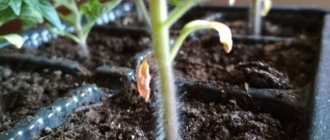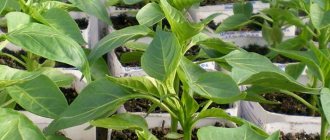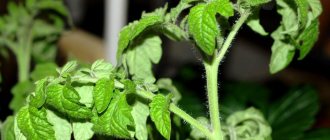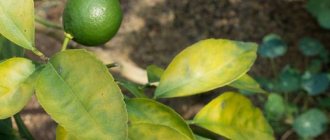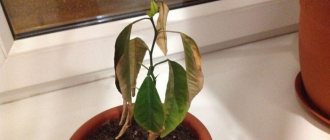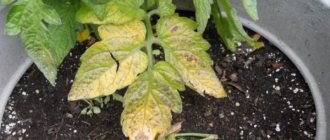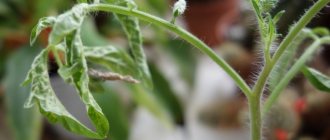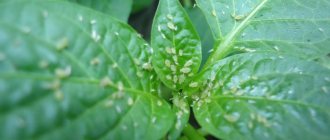Vegetable growing » Tomatoes
0
2242
Article rating
Kira Stoletova
Tomatoes are a plant that can cause a number of problems when cultivated. One of them is the weak condition of the leaves. Let's look at the reasons why the leaves of tomato seedlings fall.
Causes of leaves falling off in tomato seedlings
Yellowing and falling of the lower leaves is the first signal of improper care or violation of agricultural practices. If the cause is immediately detected and eliminated, the plant can be saved.
Improper watering
Tomatoes need regular moderate watering. Lack of moisture, as well as its excess, leads to tomato leaves falling off.
It is enough to water a young plant once every 4-5 days. If the room is dry and the soil dries out quickly, you can water it once every 2-3 days. The water should be settled and at room temperature. Cold water has a detrimental effect on the delicate roots, microflora and immunity of tomatoes.
If the room has high humidity, is cold or the seedlings are in the shade, then watering can be reduced. Excess moisture leads to rotting of the root system, the appearance of fungus in the soil and disease of all seedlings.
Signs of excess moisture
If tomatoes turn yellow and drop their leaves due to overwatering, then the first thing you need to do is inspect the soil. Clean soil does not require replacement. You just need to reduce the amount of watering. The presence of plaque, whitish spots or fluff, or a sour smell indicates that the seedlings need to be immediately transplanted into a clean, dry container and into a new soil mixture.
When replanting, carefully examine the roots of each bush. Healthy roots are white. If they are brown, then it is difficult to save the seedling - this indicates the beginning of decay.
Sudden changes in watering have a detrimental effect on seedlings. Periodic underwatering and overwatering become stressful for young bushes and growth slows down.
Pests as the cause of the problem
Pests, like diseases, can cause significant damage to tomato plantings. That is why their timely identification and destruction is so important.
Aphid
A very common pest, they are usually small green, sometimes black, insects that form fairly large settlements on the underside of leaf blades. Aphids have the property of multiplying very quickly, so the fight against them must be started as early as possible.
It feeds on plant juices, sucking them from the leaves. Leaves affected by aphids first curl, then dry out and fall off. To combat it, systemic insecticides are used.
Whitefly
In appearance it resembles butterflies with white wings. Mostly found indoors. Parasitizes on the underside of leaf blades. Like aphids, they suck the juices out of the plant, thereby contributing to the spread of fungal diseases. Whiteflies leave dry, discolored areas on the leaves . Later, the affected leaves dry out and fall off.
To combat whiteflies, systemic insecticides are used.
Lack of lighting
Tomato is a light-loving crop. Cultivation begins in February - March, when daylight hours are still short. With a lack of lighting, plants stretch, leaves develop poorly, and may begin to turn yellow and fall off. There are two ways to solve the problem:
- Add artificial lighting.
- Grow seedlings in the brightest window.
Regular incandescent lamps are of no use. It is better to use LED lamps. Their light is optimal for seedlings.
Tatyana Orlova (candidate of agricultural sciences):
Even on a south-facing window, the sun is no more than 3-4 hours a day. In this case, the plants are illuminated only on one side, the other remains in the shadow. To eliminate the deficiency of light, fluorescent fluorescent lamps are used. They are placed on top of the seedlings at a distance of no more than 1 meter.
Lack of nutrients in the soil
Lack of nitrogen negatively affects plants
Young bushes grow quickly and require regular feeding. Before flowering begins, plants actively increase their green mass. The main building element is nitrogen. It is its deficiency that leads to yellowing and death of the lower leaves.
Nitrogen deficiency can be remedied by applying organic fertilizers. It must be remembered that excess nitrogen can have a detrimental effect on future harvests. Active growth of leaves and compaction of the stem indicate that the crop receives sufficient nutrients.
It is recommended to carry out the first feeding in the phase of 3 - 4 true leaves, the next - after 2 weeks. The last feeding is carried out 10 days before planting.
In addition to nitrogen, there may be a lack of copper, potassium, and iron. A lack of elements can also cause yellowing and falling off.
Fertilizers
Leaves on tomatoes fall off due to excess or lack of nutrients.
- This phenomenon is possible when there is a lack of nitrogen in the soil. The first feeding of the sprouts is carried out at the stage of appearance of the first true leaves. Add a solution of urea or nitrophoska (1 tbsp per 10 liters of water). Liquid fertilizer promotes the full growth of the root and vegetative parts of tomatoes.
- Yellowing, curling and falling of leaves is one of the reasons for the lack of phosphorus and potassium. 3 weeks after planting in the garden, the seedlings need to be fed with superphosphate and potassium salt at the rate of 15 g per bucket of water. 0.5 liters of solution is poured under one bush.
- If leaves fall en masse on tomato seedlings, it may be suffering from a lack of iodine or boron. This problem can be eliminated by spraying the sprouts with a solution of boric acid (0.2 g per 1 liter of hot water) and iodine (1 drop per 3 liters of water). Foliar feeding prevents leaf loss and increases resistance to many nightshade diseases.
- Darkened tomato leaves with a bluish tint are a sure sign of a copper deficiency. Over time, the leaves wither and fall off. You can compensate for the lack of this microelement by spraying the sprouts with copper-containing products - copper sulfate (2 g per 10 liters of water) or “Kuproksat” (5 ml per 1 liter of water). The drugs “Abiga-Pik” and “Hom” are considered no less effective.
Leaves on tomatoes can also fall off due to excess fertilizer in the soil, so you should strictly follow the dosage and application schedule of each component.
Temperature changes
The choice of location in the apartment plays an important role for the normal development of tomatoes. Seedlings grow well in a warm, draft-free place.
At high temperatures (if the heating season has not ended), the leaves will fall off.
Spring night frosts can also cause significant damage. If the temperature at night is below 12 °C, the tomatoes will wilt.
Tatyana Orlova (candidate of agricultural sciences):
Prolonged cold spells are detrimental to tomatoes, when the air and soil temperature drops to +10 degrees and lasts 7-10 days. This can lead to the stopping of all processes in the plant.
Unsuitable soil
Tomatoes grown from seed at home or in a greenhouse wither due to an incorrectly selected soil mixture.
Acidic and dense soil entails:
- yellowing;
- falling off;
- drying of seedlings at the rhizome.
In addition to unsuitable soil, the reason may lie in the presence of pathogenic microorganisms or harmful beetles in it. This happens in the absence of preliminary disinfection. The procedure is carried out with a weak solution of potassium permanganate or hot water 90 degrees, calcination of the earth or freezing.
Infection in soil mixture
Sometimes the reason why the lower leaves of tomato seedlings fall off is poor soil. A soil mixture purchased in a store does not always guarantee its quality, while a garden mixture requires good treatment and disinfection before use.
Fungus in the soil appears as mold on the surface. It should not be confused with salt crust. The crust is a whitish dense coating that no longer appears after removing and adding a fresh portion.
The causes of mold may be:
- waterlogging and poor drainage;
- heavy soil;
- contaminated soil;
- too dense planting of seedlings, insufficient ventilation between plants.
The most radical and effective method of getting rid of fungus is to completely replace the soil. Mold is difficult to remove and can return quickly. The fungus penetrates through the roots into all parts of the plant and leads to its death.
Tatyana Orlova (candidate of agricultural sciences):
Molds are saprophytes, i.e. organisms that feed on dead organic matter, which is found in large quantities in the soil for seedlings. But in conditions of limited soil volume, they become competitors to higher plants - tomato seedlings or seedlings and suppress their growth.
Before transplanting, the planting containers must be thoroughly washed and disinfected. The seedlings need to be carefully washed to remove any remaining old soil. Those tomatoes that are infected or have rotten roots cannot be planted. Before planting in the ground, the roots of the seedlings are disinfected in a solution of Fitosporin-M or Fundazol. This will prevent the development of fungus.
To prevent the development of fungus, you need to avoid dense plantings and carefully monitor the frequency of watering. If necessary, periodically dry the air and ventilate the room more often.
Why do the leaves dry out on tomato seedlings?
Most often, seedling leaves dry out due to too high a temperature in the room. If a box with plants is located, for example, near a working radiator, you need to move it to another place or fence it off from the heat source using wide plywood. Also, seedlings dry out due to insufficient humidity in the room; use a humidifier or simply place large containers of water next to the seedlings.
The cause of leaf drying may be salting of the substrate due to watering with hard water or excessive fertilizing. In this case, it is recommended to carefully remove the top layer of soil and add fresh soil.
The main signs of soil salinity are white or yellowish spots on the surface
If the leaves begin to dry out after picking, it means that the roots of the seedling have been damaged . To bring the plant back to life faster, you can spray it with a weak solution of complex mineral fertilizer.
Lack of room to grow
If tomatoes grow in one container for a long time, then the root system will have nowhere to develop. In such a situation, the bush sheds its leaves so as not to overload itself. To avoid this, you need to monitor the size of the tomato and replant it in time into containers of appropriate size.
It is important to remember that when transplanting, intertwined roots are injured. After planting in a new place, they will begin to recover and grow actively, thereby slowing down the development of the above-ground part.
Tatyana Orlova (candidate of agricultural sciences):
Crowded crops are the most common cause of tomato leaf drop. Plants are affected by two negative factors at once - lack of light (seedlings stretch out), lack of nutrition - first the cotyledon leaves turn yellow and are shed, then the lower pair of true leaves.
Why do tomato seedlings lose their leaves?
The falling off of the very first leaves of seedlings (cotyledons) is a natural process, and there is no need to worry, but if the real leaves begin to change color and shape, and then dry out and fall off, this may be a symptom of diseases that need to be diagnosed and urgent protective measures taken.
What to do?
To provide first aid to the affected plant, transplant the seedling into fresh soil, then pour 20 ml of potassium permanganate solution (0.5 g of powder per 100 ml of water) under the root and move the box with the seedlings to a well-lit place. When replanting, carefully clean the roots from the soil and remove yellow and blackening roots. If you don’t have fresh, disinfected substrate at hand, you can wash the old soil with plenty of water.
As you can see, the main thing in growing seedlings of any crop is to maintain optimal conditions for the healthy development of the plant and carefully monitor the seedlings.
